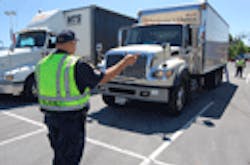An ongoing “culture change” among drivers of all types of vehicles is helping drive improvements in highway safety, according to the Commercial Vehicle Safety Alliance (CVSA), but it’s a change in outlook that must continue to be nurtured in order to take permanent root.
Stephen Keppler, CVSA’s executive director, noted that efforts to educate young drivers (ages 16-20) seem to be proving effective. According to recently released data from the National Highway Traffic Safety Administration (NHTSA), there was a 39% decrease in fatalities in young driver-involved crashes between 2006 and 2010 compared to a 23% decrease in overall fatalities during the same time frame.
Keppler also pointed to the results of CVSA’s fourth annual Operation Safe Driver campaign, conducted in late October last year. Some 44,000 commercial and passenger vehicle drivers were stopped as part of that campaign, which involved 3,805 law enforcement personnel at 1,848 locations across the U.S. and Canada. Some of the results include:
- Of the 20,804 commercial vehicle driver traffic enforcement contacts made during the eight day campaign, 7,062 warnings (0.32 per contact) and 8,121 citations were issued (0.35 per contact), both declines from 2010, when there were 21,555 contacts resulting in 7,062 warnings (0.33 per contact) and 8,067 citations (0.40 per contact).
- Of the 8,770 non-commercial vehicle driver contacts, 7,126 warnings (0.52 per contact) and 7,256 citations were issued (0.69 per contact) versus 2010 when 7,700 contacts resulted in 3,818 warnings (0.60 per contact) and 6,477 citations (0.68 per contact).
- Of the 34,725 commercial vehicle roadside inspections conducted, 4.7% resulted in the driver being placed out-of-service, with 24.6% of vehicles being placed out of service (OOS) during Level I inspections. In 2010, there were 39,784 inspections conducted and a driver OOS rate of 5.3% and vehicle Level I OOS rate of 27.4%.
- For commercial drivers during 2011’s campaign, that resulted in 0.81 violations per roadside inspection (0.44 in 2010) and 0.08 OOS violations per roadside inspection (same in 2010), with 0.07 citations per roadside inspection (0.04 in 2010).
- Finally, commercial vehicle drivers were issued significantly less warnings and citations in 2011 for failing to buckle up (416) as compared to 2010 (1,055).
Operation Safe Driver got started in 2007 by CVSA in partnership with the Federal Motor Carrier Safety Administration (FMCSA) to address the problem of improving the behavior of all drivers operating in an unsafe manner — either by, in, or around commercial vehicles — and to initiate educational and enforcement strategies to address those exhibiting high-risk behaviors.
In an interview with Fleet Owner, Keppler said that safety wise – especially where trucking is concerned – “everything is trending in the right direction,” despite the uptick in fatalities from truck-car crashes reported by NHTSA at the end of last year.
“We really need to dig into the details of those numbers to see what’s really going on there, but overall, I do believe we’re trending in the right direction,” he stressed.
“I’ve been in this industry for 20 years and the safety changes we’ve seen over the last five years have been unbelievable,” Keppler explained. “We’ve seen the imposition of the CSA [Compliance, Safety, Accountability] program and efforts to mandate EOBRs [electronic onboard recorders] to intermodal chassis rules governing equipment safety. There’s an awful lot of activity going on, especially where safety rules and regulations are concerned.”
The key to further improvements in highway safety, Keppler pointed out, will be continuing to focus on changing the driving “culture” and not so much the rules.
“Shifting behavior is the real critical element in all of this,” he said. “The bulk of the industry is making the right decisions when it comes to safety, but many still don’t understand the ‘value equation’ when it comes to how safe driving impacts [trucking] profits. That’s the shift that has to occur.”
About the Author
Sean Kilcarr
Editor in Chief
Sean Kilcarr is a former longtime FleetOwner senior editor who wrote for the publication from 2000 to 2018. He served as editor-in-chief from 2017 to 2018.
